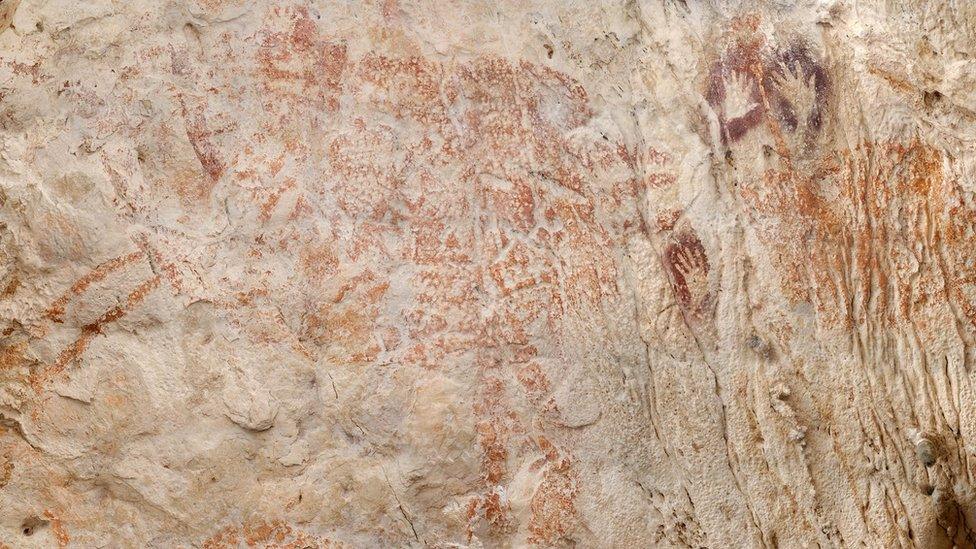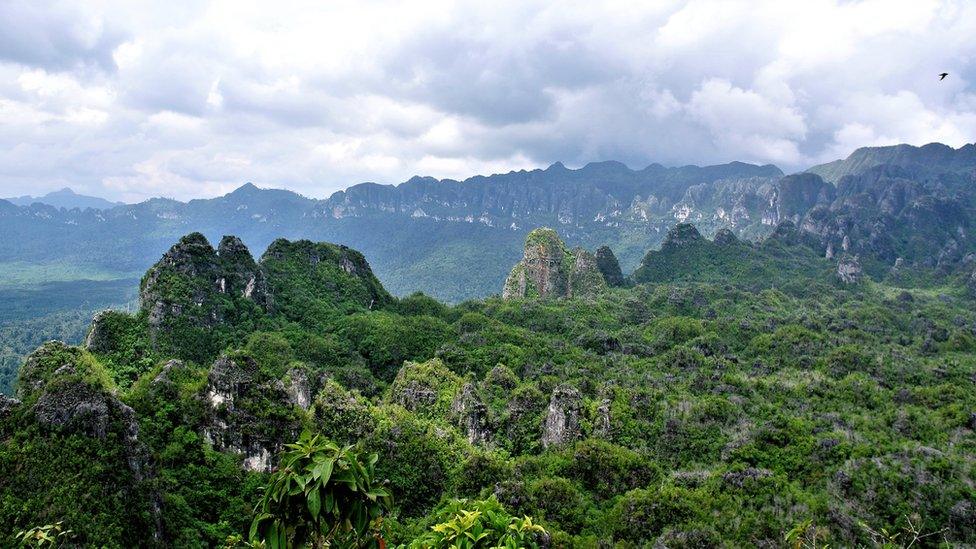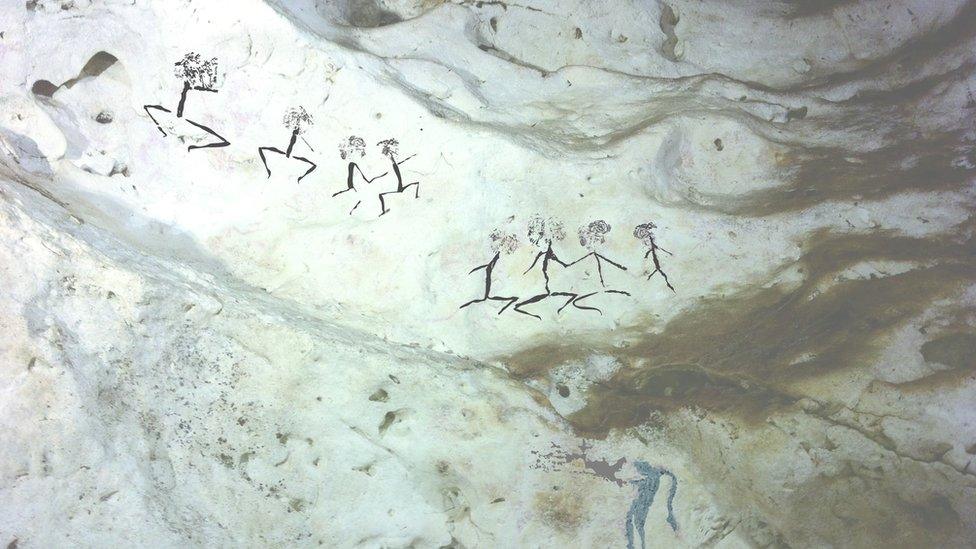'Oldest animal painting' discovered in Borneo
- Published

This tracing of the cave wall shows the 40,000-year-old painting on the far right. The black box shows the area which was used for dating the cave art
The earliest known painting of an animal has been identified in a cave on the island of Borneo.
The artwork, which is at least 40,000 years old, is thought to be the oldest example of figurative painting - where real objects are depicted rather than abstract shapes.
The researchers aren't certain what animal it represents, but their hunch is that it's a banteng, a type of wild cow that lives in the area today.
The work appears in Nature journal., external
The painting was found in a system of caves in the remote and rugged mountains of East Kalimantan, an Indonesian province on Borneo.
The caves contain thousands of other prehistoric paintings, drawings and other imagery, including hand stencils, animals, abstract signs and symbols.

The 40,000-year-old animal painting can be seen on the far right of this image of the cave wall
"This is a very large area with many paintings and many caves - it's a major archaeological discovery," said Prof Francesco d'Errico, an authority on prehistoric art from the University of Bordeaux, France, who was not involved in the latest research.
Co-author Maxime Aubert, from Griffith University in Australia, commented: "The oldest cave art image we dated is a large painting of an unidentified animal, probably a species of wild cattle still found in the jungles of Borneo - this has a minimum age of around 40,000 years and is now the earliest known figurative artwork."
The animal appears to have a spear shaft stuck in its flank and is one of a series of similar red-orange coloured paintings, which were made with iron-oxide pigment.
These paintings, which include other depictions of animals along with hand stencils, appear to represent the oldest phase of art in the cave.
Scientists spent several days trekking through rural Borneo to find the 40,000-year-old artwork.
The animals, said Dr Aubert, are "painted in the same style with a large body and small legs".
To come up with the 40,000-year date for the painting of the animal, Dr Aubert and colleagues used scientific dating techniques on calcium carbonate deposits close to the image.
The researchers also managed to date two red-orange hand stencils, which yielded minimum ages of 37,000 years. A third hand stencil - an example of abstract, rather than figurative art - had a maximum age of 51,800 years, even older than the animal painting.
The authors conclude that rock art locally developed in Borneo between around 52,000 and 40,000 years ago.
The second phase of painting in the cave is characterised by the use of purple-coloured paint, and dates to between 16,000 and 21,000 years ago. This phase includes some apparent depictions of humans.
Maxime Aubert said: "It looks like there was a transition from depicting the animal world to [depicting] the human world. And it's interesting because I think we have the same thing in Europe."

The caves are located in a remote and mountainous region of East Kalimantan
The prehistoric cave paintings of Lascaux and Chauvet in France, and Altamira in Spain, are similarly magnificent. They contain images of a veritable prehistoric menagerie, including cave lions, hyenas, horses, deer, rhinos and bison.
But a paper published earlier this year in the journal Science, external pushed the dates for cave art in Europe back to as much as 65,000 years. These paintings pre-date the known arrival of modern humans in Europe, leading to the study's suggestion that they might have been made by Neanderthals.
One of the authors of that paper in Science was Prof Alistair Pike, an archaeologist from the University of Southampton. Prof Pike - who was not involved with the new research - welcomed the findings, but expressed reservations about the date for the oldest figurative painting.
"I have no doubt that they have dated painting to at least 40,000 years at their oldest site, and this is an exciting result as it shows that cave painting wasn't an isolated event... but that it had a wide geographical distribution," Prof Pike explained.

The caves also contain paintings of humans; these ones date to 13,600 years ago
"But there are some doubts if their dated sample overlies the figurative art... it appears to lie over some pigment 15cm away from the animal figure, and while it once might have formed part of this figure (which is very weathered), they have not demonstrated it is part of it."
Prof d'Errico also sounded a note of caution, explaining that the discovery didn't tell us much about the geographical origins of art.
"I think things develop independently. There may be other areas where people were producing something similar but we haven't found it yet, or that it wasn't preserved," he told BBC News.
"I think that symbolic thinking and abstract representation have a long history. They develop gradually over 100,000 years if not more."
"It's probably something that is created, abandoned and then re-created in new form."
The area of Borneo where the caves are located is relatively unexplored, so there could be many other examples waiting to be found.
The same team recently reported dates as old as 39,000 years old for cave art from the nearby island of Sulawesi.
Follow Paul on Twitter., external